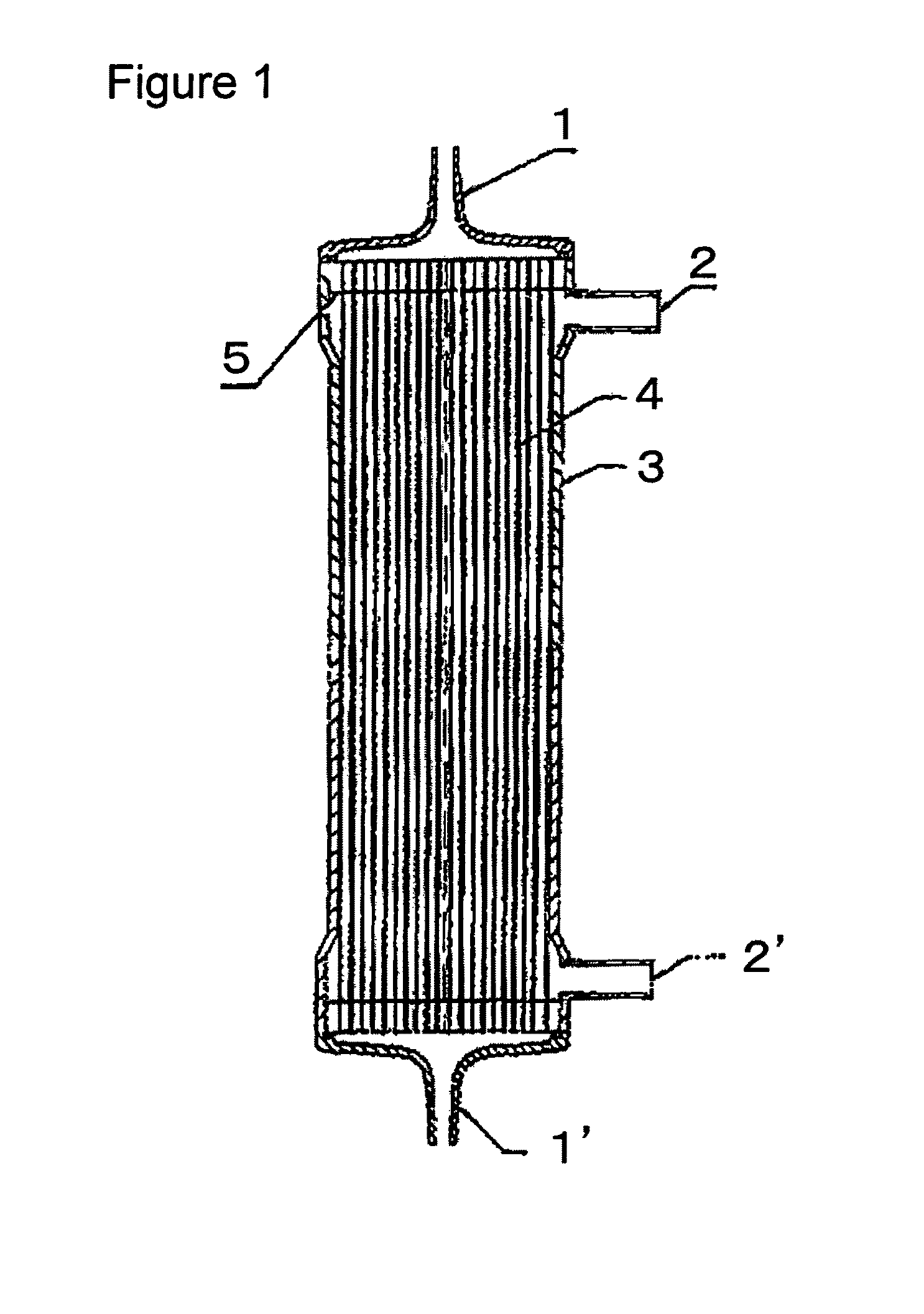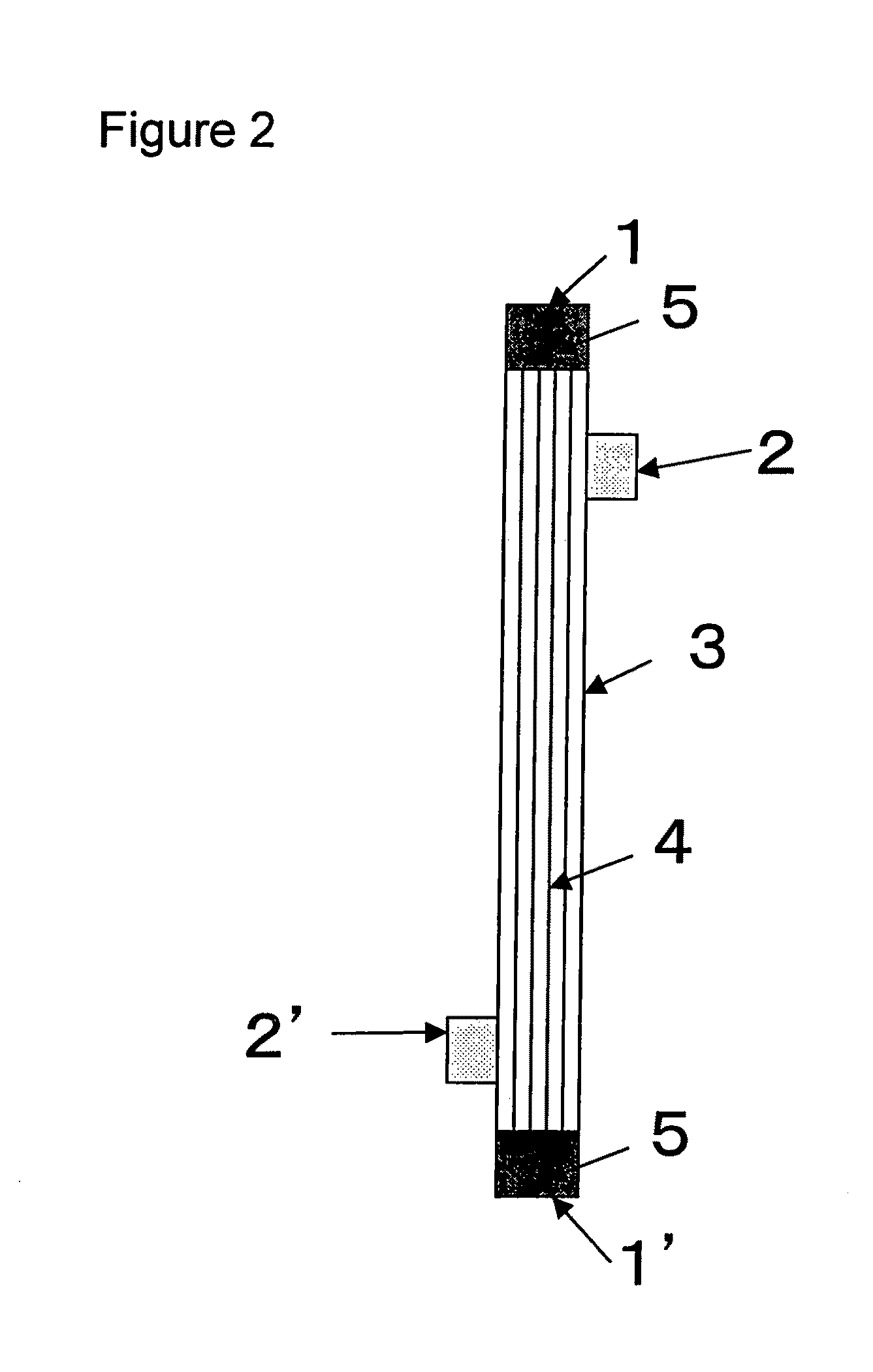Substrate and method for production thereof
a surface modification technology and substrate technology, applied in the field of substrate and surface modification technology, can solve the problems of lowering anti-coagulability, increasing medical expenses, and obstructing of blood vessels, so as to reduce the risk of adverse reactions to anticoagulants, the effect of high anti-coagulability
- Summary
- Abstract
- Description
- Claims
- Application Information
AI Technical Summary
Benefits of technology
Problems solved by technology
Method used
Image
Examples
example 1
[0117]A solution (solution A) obtained by dissolving the compound A and a compound B, being a copolymer (F-3031 (lot. 410104) available from Shin-Etsu Chemical Co., Ltd.) of polyether and polysiloxane, in a Tris buffer of pH 7.8 in such a way that the concentrations thereof were as listed in Table 1 was prepared and 0.5 L of the solution A entered at a flow rate of 160 ml / min from the one blood port 1 inside the hollow fibers 4 of the module (0) and exited from the other blood port 1 after passing through the hollow fibers 4, and entered to the dialyzing fluid port 2′ on the blood port 1′ side via a tube (not shown) and exited to the other dialyzing fluid port 2 (hereinafter, this sequence is referred to as “Sequence 1”) to circulate for 15 min. Subsequently, physiological saline entered at a flow rate of 100 ml / min by a pump from the one blood port 1 inside the hollow fibers 4 and reached to the dialyzing fluid port 2′ for 75 min to obtain a module (1).
[0118]The module (1) was used...
example 2
[0119]A solution (solution B) was prepared under the same conditions as in Example 1 except that the compound A, the compound B and IPA (code 10982-7 available from Aldrich) were dissolved in such a way that the concentrations thereof were as listed in Table 1, and 2 L of the solution B was circulated at a flow rate of 500 ml / min through the module (0) by the pump in Sequence 1 for 15 min. Next, the module (0) was irradiated with γ ray while ports at four locations were sealed up. The absorbed dose of γ ray was 26 kGy. The inside of the module was cleaned in the following way: 5 L of aqueous solution of 0.025 vol % of polyoxyethylene octylphenylether (Code 30-5140-5 manufactured by Sigma Aldrich (hereinafter, referred to as TritonX-100)) at 25° C. was circulated at a flow rate of 500 ml / min by the pump in Sequence 1 for four hours for cleaning. Then, similarly cleaning was again performed by 5 L of an aqueous solution of 0.025 vol % of TritonX-100 for four hours. Subsequently, 50 L ...
example 3
(1) Creation of Base Material
[0125]A solution of 18 parts by weight of PSf (“Udel” P-3500 available from Teijin Amoco), 6 parts by weight of PVP (K90 available from BASF), 3 parts by weight of PVP (K30 available from BASF), 72 parts by weight of N,N-dimethyl acetamide (hereinafter, referred to as DMAc), and 1 part by weight of water was prepared. Subsequently, the solution was applied to glass plates sandwiching a spacer of thickness 0.1 mm and spread like a film by a doctor blade and then, immediately the glass plates were dipped in a solution prepared to 52 parts by weight of DMAc and 48 parts by weight of water to solidify the film, the film was solidified and peeled off the glass plates to obtain as a base material.
(2) Treatment Method of Immobilizing the Compound A and Compound B
[0126]The solution as the solution B in Example 2 was prepared, and 5 ml thereof was dispensed into each 15 ml centrifugation tube (manufactured by IWAKI). The base material created in (1) was rolled up...
PUM
| Property | Measurement | Unit |
|---|---|---|
| blood coagulation time | aaaaa | aaaaa |
| pH | aaaaa | aaaaa |
| concentration | aaaaa | aaaaa |
Abstract
Description
Claims
Application Information
 Login to View More
Login to View More - R&D
- Intellectual Property
- Life Sciences
- Materials
- Tech Scout
- Unparalleled Data Quality
- Higher Quality Content
- 60% Fewer Hallucinations
Browse by: Latest US Patents, China's latest patents, Technical Efficacy Thesaurus, Application Domain, Technology Topic, Popular Technical Reports.
© 2025 PatSnap. All rights reserved.Legal|Privacy policy|Modern Slavery Act Transparency Statement|Sitemap|About US| Contact US: help@patsnap.com



